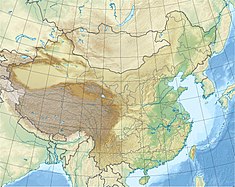Baihetan Dam
| Baihetan Dam | |
|---|---|
 Location of Baihetan Dam in China | |
| Official name | 白鹤滩大坝 |
| Coordinates | 27°13′07″N 102°54′22″E / 27.21861°N 102.90611°ECoordinates: 27°13′07″N 102°54′22″E / 27.21861°N 102.90611°E |
| Construction began | 2017 |
| Opening date | July 2022 |
| Construction cost | CN¥220 billion[1] |
| Dam and spillways | |
| Type of dam | double-curvature arch dam |
| Impounds | Jinsha River |
| Height | 277 metres (909 ft) |
| Width (crest) | 13 metres (43 ft) |
| Width (base) | 72 metres (236 ft) |
| Reservoir | |
| Total capacity | 17,924,000,000 m3 (14,531,223 acre⋅ft)[2] |
| Power Station | |
| Turbines | 16 × 1,000 MW |
| Installed capacity | 4 000 MW (operational) 12,000 MW (under construction) |
| Annual generation | 60.24 TWh[3] |
The Baihetan Dam (simplified Chinese: 白鹤滩大坝; traditional Chinese: 白鶴灘大壩; pinyin: Báihètān Dàbà) is a large hydroelectric dam on the Jinsha River, an upper stretch of the Yangtze River in Sichuan and Yunnan provinces, in the southwest of China. The dam is a 277 m tall double-curvature arch dam with a crest elevation of 827 m, and a width of 72 m at the base and 13 m at the crest.[3] It is considered the last large hydropower project in China to be completed since a series of projects starting with the Three Gorges Dam,[4] the third largest dam in China and the fourth in the world, in terms of dam volume.
Power generation[]
The facility will generate power by utilizing 16 turbines, each with a generating capacity of 1.0 GW, taking the generating capacity to 16,000 MW.[5] In terms of generating capacity, it will be the second largest hydroelectric power plant in the world, after the Three Gorges Dam.[6]
Construction[]
Surveying of the dam site was done in 1992.[7] The dam was originally scheduled to be constructed between 2009 and 2018.[8] Actual construction started in 2017.[9] The reservoir started filling in April 2021, with the dam to start partial electricity generation in July of the same year. By July 2022, the dam should be fully operational.[10] Experts have noted the 4-year construction period as being exceptionally fast for a project of its type.[11]
On June 28, 2021, the Baihetan Dam began generating electricity, when the project's first two turbines started operating.[12] The third turbine followed in July and the fourth in November.[13]
See also[]
- Wudongde Dam, the next dam upstream
- Xiluodu Dam, the next dam downstream
- List of power stations in China
- List of largest power stations
References[]
- ^ Xie, Echo (28 June 2021). "China turns on world's first giant hydropower turbines". South China Morning Post. Retrieved 6 July 2021.
- ^ "Baihetan Hydropower" (in Chinese). Baihetan. Archived from the original on 19 April 2014. Retrieved 23 August 2011.
- ^ a b "Baihetan Hydropower Project". CWE. Archived from the original on 2016-03-02. Retrieved 2016-02-20.
- ^ "China's Era of Mega-Dams Is Ending as Solar and Wind Power Rise". Bloomberg.com. 2020-07-03. Retrieved 2021-04-09.
- ^ "中国东方电气集团有限公司". www.dongfang.com.
- ^ "环保部审批金沙江白鹤滩水电站环境影响报告书(附文) - 北极星水力发电网". news.bjx.com.cn. Retrieved 2020-12-17.
- ^ Chen, Houqun; Wu, Shengxin; Dang, Faning (2015-11-10). Seismic Safety of High Arch Dams. Elsevier. ISBN 978-0-12-803627-3.
- ^ "A Brief History of Hydropower Development Baihetan" (in Chinese). Baihetan China - Ningxia County Public Information Network. 2 December 2009. Archived from the original on 23 August 2011. Retrieved 20 March 2011.
- ^ "巧家政府网-巧家县人民政府门户网站". www.qiaojia.gov.cn. Retrieved 2020-12-17.
- ^ "New mega hydropower station to begin operations - China.org.cn". www.china.org.cn. Retrieved 2021-04-09.
- ^ "How China built the world's largest arch dam in just four years". South China Morning Post. 2021-03-16. Retrieved 2021-04-09.
- ^ "China starts Baihetan hydro project, biggest since Three Gorges". Reuters. 28 June 2021.
- ^ "白鹤滩水电站4号机组投运 左岸机组投产发电任务完成过半_四川在线". sichuan.scol.com.cn. Retrieved 2021-12-05.
- Hydroelectric power stations in Yunnan
- Hydroelectric power stations in Sichuan
- Dams in China
- Dams on the Jinsha River
- Buildings and structures in Zhaotong
- 2021 establishments in China
- Dams completed in 2021
- Hydroelectric power plant stubs
- Asian dam stubs
- Power station stubs
- People's Republic of China building and structure stubs